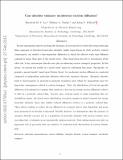| dc.contributor.author | Lee, Elizabeth M. | |
| dc.contributor.author | Tisdale, William | |
| dc.contributor.author | Willard, Adam P. | |
| dc.date.accessioned | 2017-07-07T15:19:25Z | |
| dc.date.available | 2017-07-07T15:19:25Z | |
| dc.date.issued | 2015-06 | |
| dc.date.submitted | 2015-02 | |
| dc.identifier.issn | 1520-6106 | |
| dc.identifier.issn | 1520-5207 | |
| dc.identifier.uri | http://hdl.handle.net/1721.1/110532 | |
| dc.description.abstract | Recent experiments aimed at probing the dynamics of excitons have revealed that semiconducting films composed of disordered molecular subunits, unlike expectations for their perfectly ordered counterparts, can exhibit a time-dependent diffusivity in which the effective early time diffusion constant is larger than that of the steady state. This observation has led to speculation about what role, if any, microscopic disorder may play in enhancing exciton transport properties. In this article, we present the results of a model study aimed at addressing this point. Specifically, we introduce a general model, based upon Förster theory, for incoherent exciton diffusion in a material composed of independent molecular subunits with static energetic disorder. Energetic disorder leads to heterogeneity in molecule-to-molecule transition rates, which we demonstrate has two important consequences related to exciton transport. First, the distribution of local site-specific hopping rates is broadened in a manner that results in a decrease in average exciton diffusivity relative to that in a perfectly ordered film. Second, since excitons prefer to make transitions that are downhill in energy, the steady state distribution of exciton energies is biased toward low-energy molecular subunits, those that exhibit reduced diffusivity relative to a perfectly ordered film. These effects combine to reduce the net diffusivity in a manner that is time dependent and grows more pronounced as disorder is increased. Notably, however, we demonstrate that the presence of energetic disorder can give rise to a population of molecular subunits with exciton transfer rates exceeding those of subunits in an energetically uniform material. Such enhancements may play an important role in processes that are sensitive to molecular-scale fluctuations in exciton density field. | en_US |
| dc.description.sponsorship | National Science Foundation (U.S.) (1122374) | en_US |
| dc.language.iso | en_US | |
| dc.publisher | American Chemical Society (ACS) | en_US |
| dc.relation.isversionof | http://dx.doi.org/10.1021/acs.jpcb.5b01886 | en_US |
| dc.rights | Article is made available in accordance with the publisher's policy and may be subject to US copyright law. Please refer to the publisher's site for terms of use. | en_US |
| dc.source | arXiv | en_US |
| dc.title | Can Disorder Enhance Incoherent Exciton Diffusion? | en_US |
| dc.type | Article | en_US |
| dc.identifier.citation | Lee, Elizabeth M. Y.; Tisdale, William A. and Willard, Adam P. "Can Disorder Enhance Incoherent Exciton Diffusion?" The Journal of Physical Chemistry B 119, 30 (June 2015): 9501–9509 © 2015 American Chemical Society | en_US |
| dc.contributor.department | Massachusetts Institute of Technology. Department of Chemical Engineering | en_US |
| dc.contributor.department | Massachusetts Institute of Technology. Department of Chemistry | en_US |
| dc.contributor.mitauthor | Lee, Elizabeth M. | |
| dc.contributor.mitauthor | Tisdale, William | |
| dc.contributor.mitauthor | Willard, Adam P. | |
| dc.relation.journal | The Journal of Physical Chemistry B | en_US |
| dc.eprint.version | Original manuscript | en_US |
| dc.type.uri | http://purl.org/eprint/type/JournalArticle | en_US |
| eprint.status | http://purl.org/eprint/status/NonPeerReviewed | en_US |
| dspace.orderedauthors | Lee, Elizabeth M. Y.; Tisdale, William A.; Willard, Adam P. | en_US |
| dspace.embargo.terms | N | en_US |
| dc.identifier.orcid | https://orcid.org/0000-0001-9143-3140 | |
| dc.identifier.orcid | https://orcid.org/0000-0002-6615-5342 | |
| mit.license | PUBLISHER_POLICY | en_US |
| mit.metadata.status | Complete | |
